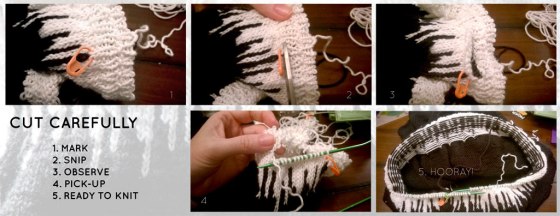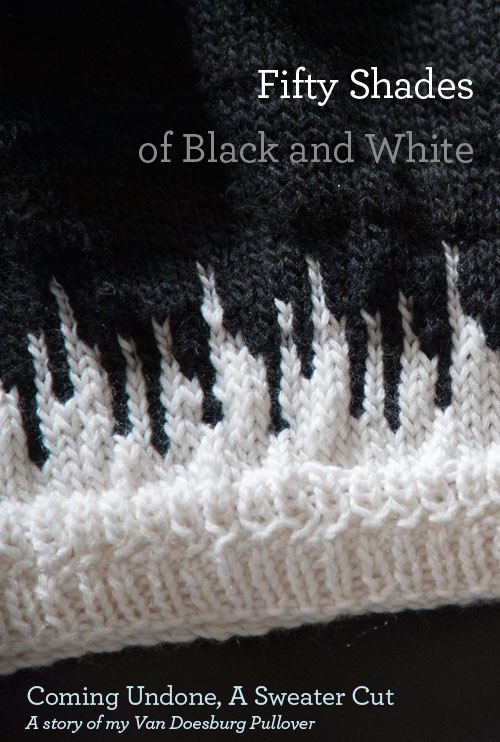
Warning: This is not a tutorial. This is my story of taking a pair of scissors to a barely finished hand knit sweater, on size 3 needles, that I just love.
Okay, now that I’ve gotten that out of the way I will next say that I have found that it often takes as much work un-knitting something, as it does knitting it. I’m not talking about frogging a sweater, or a sock, a sleeve for a hat. I am talking about taking a finished project, where all of the ends are woven in, it’s already been washed and blocked, even worn. These projects take a huge amount of attention and time to un-do.
With my Van Doesburg Pullover from Knitscene Spring 2014 –which I am naming Sonnets from Cabin 72— when I had more than halfway completed the body up past the armholes and the second color work gradation, I sad realization that I didn’t like the ribbing texture at the hem. Don’t get me wrong, the is absolutely nothing wrong with the texture. It is a 1×1 rib, with a little detail row in the middle. It is lovely, really. It’s just that, it’s not me. For me I find that the details in the color work of this sweater are playful and extraordinary, and I want them to stand alone.
This piece is worked from the bottom up in the round, and has approximately 200 stitches to each round. So to realize that you have a big problem–even if is only with the aesthetics–when you’ve completed the piece after you’ve passed the armholes can leave you with only a sad and sinking feeling of regrets. The good news was that I knew that the neckline and cuffs I wanted to do differently, and I knew how, AND, they weren’t done yet. The bad news? The hem which thousands of stitches ago had been long completed.
So I had two options:
- Rip the whole thing out
- Unravel just the hem, from the cast on edge, pick up the stitches from the from the stockinette portion at the bottom and knit downwards.
As zealous of a “frogger” as I am–meaning that I am always eager to rip out a project if it isn’t right–I had really been enjoying this project and I really didn’t want to rip out all of my hard work, because there wasn’t anything wrong with the rest of it in the size, shaping or otherwise. So option 1 was out.
Well option 2 doesn’t seem so bad, does it? It doesn’t, but I had never done it before, and I just didn’t know what would happen. A big, ominous cloud loomed over me. I put it off, and put it off. Finally I had finished the entire sweater, and after sewing one sleeve to the body I realized it was time. Why I didn’t wait until after I sewed on the second sleeve, I really can’t tell you. I guess I just felt like I had to stop and conquer my fear. I guess if I was going to ruin a whole sweater, it’d be best if I could still save a sleeve without the tedious hours of un-seaming the other.
So, I sat down with a larger sewing needle and began slowly unwinding my cast on edge. I had used a continental cast on, so I have no clue if this would happen with the others, but I guess it would. At first I couldn’t really see where to stitch, but then slowly I started to figure it out more, seeing the repetition of yarn, and finding the pattern of un-knitting.
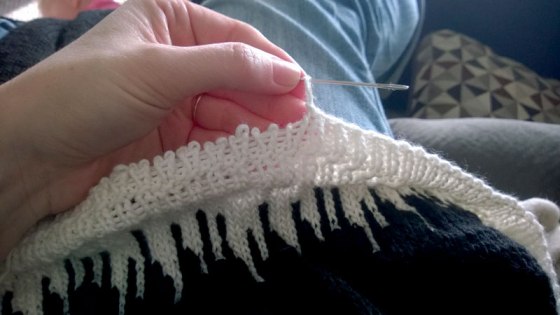
Once I got the rhythm, in the beginning each stitch took a minimum of two pulls of the needle to unloop and unknit the yarn. This took a few seconds per stitch, much longer than it took to put each stitch on the needle when I cast them on. Much, much longer. Then the tail of yarn got longer and longer, and each stitch took longer. When I was over an hour in and still hadn’t made it to the half-way point I realized that this probably wasn’t going to work out the way that I had hoped. In addition to the massive consumption of time something else strange happened: instead of pulling the yarn tail out to reveal knit stitch which easily unravel and can be picked up with a knitting needle, I had these weird knit “nubbins” that stayed firmly put, indicating that in order to rip out the hem ribbing, I would have to tediously peel the quickly growing yarn tale through each nubbin until finally I’d reached the end of the edging. But then what?
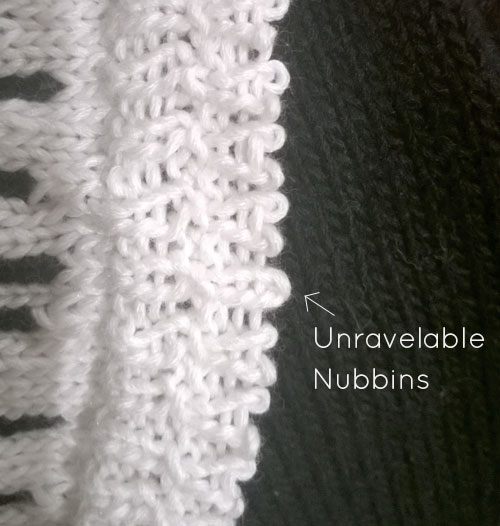
For sake of experimentation and exploring something new I decided to keep going through the cast-on round, which took a total of two and a half hours. I didn’t know if the same thing would happen in the first real “knit” round, but I had to find out. What if I got there and then pulled out a stitch or two and the whole thing easily unraveled? I’d sure be sorry if just gave up and never found the answer. Once I got to the end of the cast on round, I pulled out about five stitches of the first round, with 8 yards of yarn now being pulled through every stitch and I had the same problem: more nubbins. I must admit that I felt irritated that the Weezer song of my youth, Undone, had falsely advertised the ease in ripping out a sweater.
If you want to destroy my sweater
Hold this thread as I walk away
(As I walk away)Watch me unravel, I’ll soon be naked
(Lying on the floor)
Lying on the floor, I’ve come undone
Left with only one other option … I got out the scissors
But you’d have to be fucking crazy to take scissors to a brand new sweater, that you love, right? Needless to say my anxiety was running high. I had to sit down at the table and look at it for a long time. I had no idea how to do this, but I didn’t have any other option. I didn’t like the edging, and now the edging was ruined because of the two and a half hours I spent ripping out the cast on row. Unfinished and ugly. Those shiny silver scissors all of a sudden seemed a little–only a little–less scary. I marked the spots I wanted to work in, and with my heart beating loudly I took my first snip, then two, then a few more. Soon I had cut a 2 inch long gash into my edging. Ugh.
I paused to observe, and upon looking closer I could see knitted stitches, those familiar loops, with pieces of cut yarn going through them. Quickly I grabbed my circular needle and started to pick them up. Then after I’d picked up all of those, it became obvious that I didn’t need the scissors anymore, and that I’d in fact only needed the scissors to cut one stitch. Weezer had been right all along! Carefully I went through and picked up every stitch from the row I had cut. In less than three minutes after this, the entire edging piece had been frogged and the sweater was ready for knitting again, this time from the top down. About an hour later the new ribbing was finished, and all of the fear, frustration and anxiety was gone. A perfect end to a scary problem.
Next time I won’t hesitate to take the scissors to the piece. This was a really good lesson to learn, and I’m glad I didn’t let my fear get the better of me. I really do prefer the edging this way for my sweater. The other way was pretty, but it just wasn’t my style. And at least I know this now, too. Admitting what is and isn’t my style as opposed to what I do or don’t like really isn’t easy. You’d think they would be one in the same. I have a necklace that has a charm of a pair of sewing sheers. Perhaps I should wear this charm proudly whenever I wear my Sonnets of Cabin 72 Pullover.
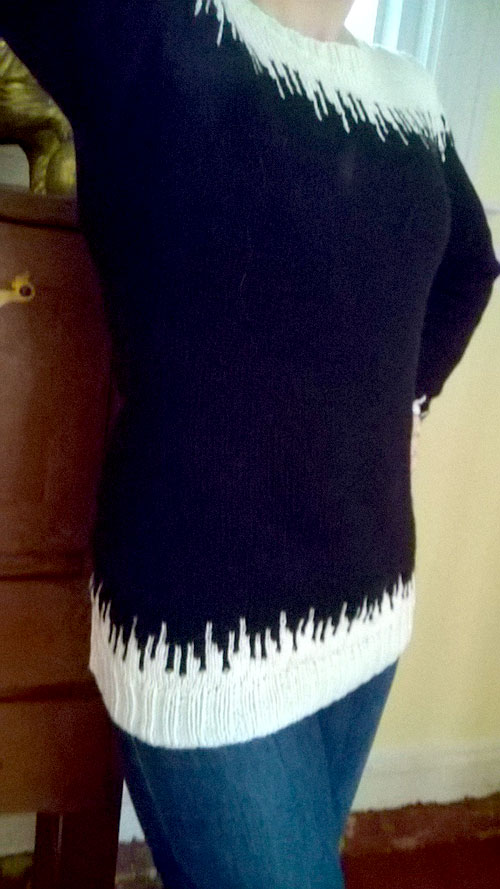
Where I’m at now. The hem changed.

